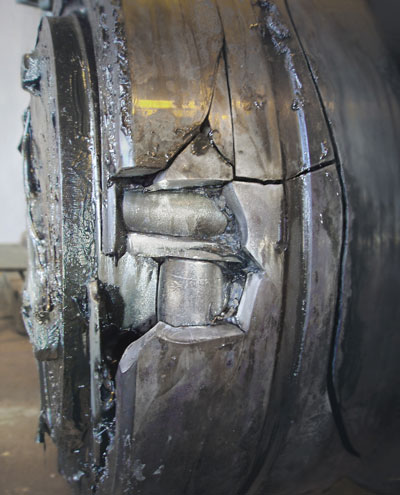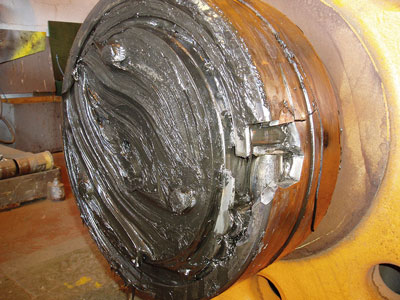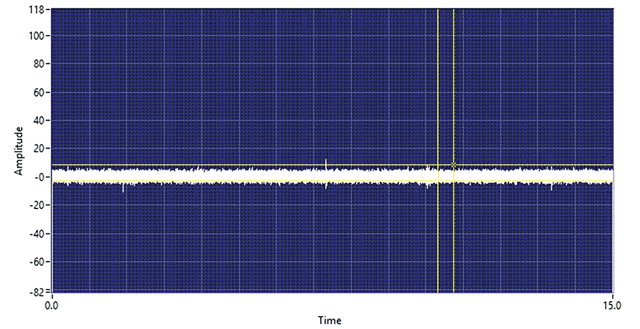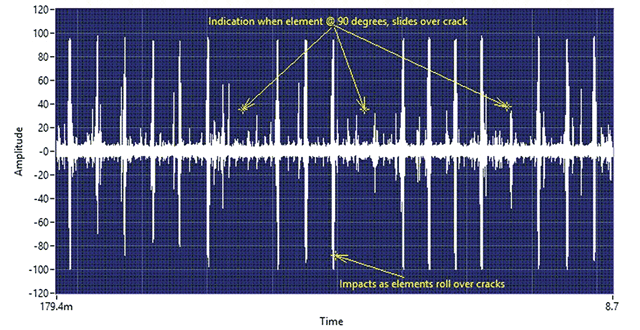Slow speed bearings produce low levels of ultrasonic noise – but an ultrasound instrument can still reveal faults by allowing the bearing’s signature in the audible frequency range to be analysed.

Vibration analysis has long been the instrument of choice to use for bearings inspection. Increasingly commonly, ultrasound is being used together with vibration analysis to help technicians confirm the condition of mechanical assets. Because of the versatility of ultrasound, if a site does not have a robust vibration analysis programme in place, ultrasound can be used to detect early stage bearing failures and other issues.
Another scenario in which ultrasound may be used first over vibration analysis is in the monitoring of slow speed bearings. In extreme slow speed bearing applications (usually less than 25rpm), the bearing will produce little to no ultrasonic noise. But because most high-end ultrasound instruments have a wide sensitivity range and frequency tuning, it is possible to listen to the audible acoustic quality of the bearing, especially at slower speeds.
In that case, it is important not only to listen to the sound of the bearing, but more importantly to analyse the recorded sound file using spectrum analysis software, focusing on the time waveform to see if there are any anomalies present. If “crackling” or “popping” sounds are present, then there is some indication of a deformity occurring. In bearing speeds above 25rpm, it is possible to set a baseline decibel level and examine the trend of the associated decibel level readings over time.

Using ultrasound to identify oven motor bearing failure
An inspection with an ultrasound instrument was carried out on a site with a newly installed oven dryer. This was a large drum oven, about 20m long by 5m wide. It was rotated by four large motors, each of them having two large sets of bearings. The motors were rotating at a speed of around 7-10 rpm, so that this was a case of extreme slow speed bearings.
An ultrasonic instrument was used to inspect all the bearings – almost all of them presented a nice and smooth sound and a 0dB reading, except for one. On one of the bearings, the ultrasonic instrument was displaying 2dB instead of 0db. Also, the audible sound heard through the headphones was different: it was not smooth as in the other bearings and it presented a repetitive “knocking” sound.
After the ultrasonic inspection, a grease sample was taken to confirm whether there was any damage on the bearing. The results of the analysis showed the presence of metal particles, confirming damage as indicated by the ultrasound instrument.
The next step was scheduling an outage to replace the bearing, which was in very bad condition. Part of the outer race came away as it was opened. It was also noticeable that one of the rollers had moved through 90°. The cage had been badly damaged too.
Ultrasound and slow speed bearings – the method
As we can see, ultrasound technology is very useful when trying to monitor the condition of slow speed bearings.
With bearings rotating at normal speeds, ultrasonic inspection can be performed by comparing changes in decibel values, establishing that a bearing with a certain value above a decibel baseline will need lubrication or already have failed.
However, with slow speed bearings, comparing dB levels and establishing alarms is not enough: in many situations the difference in the dB levels will not be significant or even non-existent. In this case, it is necessary to rely on the audible sound quality and the sound pattern. Thus it is necessary to use an ultrasonic instrument with sound recording capabilities and then analyse the sound file using sound spectrum analysis software.
The spectrum analysis of this oven motor bearing shows clearly where the roller at 90° hits the crack, as the knock stops briefly. Thus the sound pattern indicates an existing problem, being the most reliable source of information when determining the condition of a slow-speed bearing.


This find saved the company a significant amount of money: although it was necessary to get cranes in to replace such a big bearing, a job that took up to six hours, this was done during a planned outage, avoiding the costs of unplanned downtime.
Christopher Hallum, UE Systems Regional Manager UK & Ireland
+44 (0) 7930 352 188
chrish@uesystems.com
www.uesystems.co.uk

